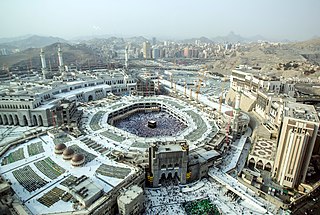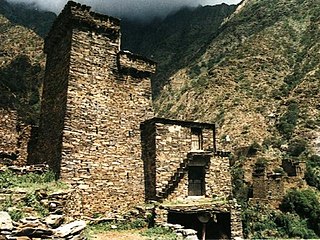
Mecca is the holiest city in Islam and the capital of Mecca Province in the Hejaz region of western Saudi Arabia. It is 70 km (43 mi) inland from Jeddah on the Red Sea, in a narrow valley 277 m (909 ft) above sea level. Its last recorded population was 1,578,722 in 2015. Its estimated metro population in 2020 is 2.042 million, making it the third-most populated city in Saudi Arabia after Riyadh and Jeddah. Pilgrims more than triple this number every year during the Ḥajj pilgrimage, observed in the twelfth Hijri month of Dhūl-Ḥijjah.

Medina, officially Al Madinah Al Munawwarah (Arabic: المدينة المنورة, romanized: al-Madīnah al-Munawwarah, lit. 'The Enlightened City', Hejazi pronunciation: [almadiːna almʊnawːara], and also commonly simplified as Madīnah or Madinah, is the second-holiest city in Islam and the capital of Medina Province in the Hejaz region of western Saudi Arabia. As of 2020, the estimated population of the city is 1,488,782, making it the fourth-most populous city in the country. Located at the core of the Medina Province in the western reaches of the country, the city is distributed over 589 km2, of which 293 km2 constitutes the city's urban area, while the rest is occupied by the Hejaz Mountains, empty valleys, agricultural spaces and older dormant volcanoes.

Taif is a city and governorate in the Makkah Region of Saudi Arabia. Located at an elevation of 1,879 m (6,165 ft) in the slopes of the Hijaz Mountains, which themselves are part of the Sarat Mountains, the city has a 2020 estimated population of 688,693 people, making it the 6th most populous city in the kingdom.

The ʿUmrah is an Islamic pilgrimage to Mecca that can be undertaken at any time of the year, in contrast to the Ḥajj, which has specific dates according to the Islamic lunar calendar.

Stephen Stapleton is an artist, social entrepreneur, and founding director of Edge of Arabia, CULTURUNNERS, and the UK charity The Crossway Foundation.

Saudi Arabia is the second biggest tourist destination in the Middle East with over 16 million visiting in 2017. Although most tourism in Saudi Arabia still largely involves religious pilgrimages, there is growth in the leisure tourism sector. As the tourism sector has been largely boosted lately, the sector is expected to be the white oil for Saudi Arabia. This is proved as tourism sector is expected to generate $25 billion in 2019. Potential tourist areas include the Hijaz and Sarawat Mountains, Red Sea diving and a number of ancient ruins.

The destruction of heritage sites associated with early Islam is an ongoing phenomenon that has occurred mainly in the Hejaz region of western Saudi Arabia, particularly around the two holiest cities of Islam, Mecca and Medina. The demolition has focused on mosques, burial sites, homes and historical locations associated with the Islamic prophet Muhammad, his companions, and many of the founding personalities of early Islamic history by the Saudi government. In Saudi Arabia, many of the demolitions have officially been part of the continued expansion of the Masjid al-Haram at Mecca and the Prophet's Mosque in Medina and their auxiliary service facilities in order to accommodate the ever-increasing number of Muslims performing the pilgrimage (hajj).

Hajj is an annual Islamic pilgrimage to Mecca, Saudi Arabia, the holiest city for Muslims. Hajj is a mandatory religious duty for Muslims that must be carried out at least once in their lifetime by all adult Muslims who are physically and financially capable of undertaking the journey, and of supporting their family during their absence from home.
Saudi Arabian art should be understood in the light of the country being the birthplace of Islam and to include both the arts of Bedouin nomads and those of the sedentary peoples of regions such as the Hejaz, Tihamah, Asir and Najd.

The Sharjah Museum of Islamic Civilization is a museum in Sharjah, United Arab Emirates (UAE). The museum, opened in 2008, covers Islamic culture, with more than 5,000 artifacts from the Islamic world. Objects include calligraphy, carvings, ceramics, coins, glass, manuscripts, metalwork, and scientific instruments. It was formerly known as the Islamic Museum and opened in 1996 before being moved and re-housed in the current building.
Edge of Arabia is an independent arts initiative developing the appreciation of contemporary Arab art and culture with a particular focus on Saudi Arabia. As a social enterprise Edge of Arabia is committed to reaching new audiences and improving understanding through touring, non-commercial & free exhibitions, through publications, and through education programs targeting schools & universities.

The Sharjah Art Museum is an art museum in the city of Sharjah, United Arab Emirates. It was housed in Bait Al Serkal in Al Shuwaihean Area. It is one of the leading art institutions in the Persian Gulf region.
Abdulnasser Gharem is a Saudi Arabian artist and also a lieutenant colonel in the Saudi Arabian army. In April 2011, his installation Message/Messenger sold for a world record price at auction in Dubai.
There has been an increase in public galleries exhibiting modern art in Saudi Arabia. This is supported by the influx of commercial galleries in the country and a growing grass-roots movement of artists which have acquired international status. Saudi Arabia is making its mark on the contemporary art scene and at the centre of this are women. These artists are noted for pushing at existing boundaries in the socially conservative country. Their work is largely feminist in nature—posing questions on the current political climate and women’s rights. They question existing parameters and challenge proposed gender roles and social norms and use art to express injustices in order to give voice to an otherwise marginalized group.

Manal Al Dowayan is a Saudi Arabian contemporary artist, best known for her installation piece Suspended Together from the Home Ground Exhibition at the Barjeel Art Foundation in 2011. She has shown work in a number of shows including the 2012 Soft Power show at Alan Art Center in Riyadh, Saudi Arabia, the 2013 Journey of Belonging, a solo show at Athr Gallery in Jeddah, Saudi Arabia, the 2017 100 Masterpieces of Modern and Contemporary Arab Art in Paris, France, as well as having her work exhibited in the 2014 USA Biennial in Houston, the 2015 P.3: Prospect New Orleans USA Biennial Notes For Now, and the Venice Biennale in the Future of a Promise Exhibition. Her work spans many mediums from photography to installation and focuses on a progressive examination and critique women's roles in Saudi society.
Shadia Alem or Shādiyah 'Ālim or in Arabic: شادية عالم is a Saudi Arabian visual artist.

The Khalili Collection of the Hajj and the Arts of Pilgrimage is a private collection of around 5,000 items relating to the Hajj, the pilgrimage to the holy city of Mecca which is a religious duty in Islam. It is one of eight collections assembled, conserved, published and exhibited by the British-Iranian scholar, collector and philanthropist Nasser Khalili; each collection is considered among the most important in its field. The collection's 300 textiles include embroidered curtains from the Kaaba, the Station of Abraham, the Mosque of the Prophet Muhammad and other holy sites, as well as textiles that would have formed part of pilgrimage caravans from Egypt or Syria. It also has illuminated manuscripts depicting the practice and folklore of the Hajj as well as photographs, art pieces, and commemorative objects relating to the Hajj and the holy sites of Mecca and Medina.

A sitara or sitarah is an ornamental curtain used in the sacred sites of Islam. A sitara forms part of the kiswah, the cloth covering of the Kaaba in Mecca. Another sitara adorns the Prophet's Tomb in the Al-Masjid an-Nabawi mosque in Medina. These textiles bear embroidered inscriptions of verses from the Quran and other significant texts. Sitaras have been created annually since the 16th century as part of a set of textiles sent to Mecca. The tradition is that the textiles are provided by the ruler responsible for the holy sites. In different eras, this has meant the Mamluk Sultans, the Sultans of the Ottoman Empire, and presently the rulers of Saudi Arabia. The construction of the sitaras is both an act of religious devotion and a demonstration of the wealth of the rulers who commission them.
Basmah Felemban is a Saudi Arabian, self-taught graphic designer. She has an interest in symbolism and Islamic metaphysics.

Hajj: Journey to the Heart of Islam was an exhibition held at the British Museum in London from 26 January to 15 April 2012. It was the world's first major exhibition telling the story, visually and textually, of the hajj: the pilgrimage to Mecca which is one of the five pillars of Islam. Textiles, manuscripts, historical documents, photographs, and art works from many different countries and eras were displayed to illustrate the themes of travel to Mecca, hajj rituals, and the Kaaba. More than two hundred objects were included, drawn from 40 public and private collections in a total of 14 countries. The largest contributor was David Khalili's family trust, lending a large number of objects that would later be part of the Khalili Collection of Hajj and the Arts of Pilgrimage.














